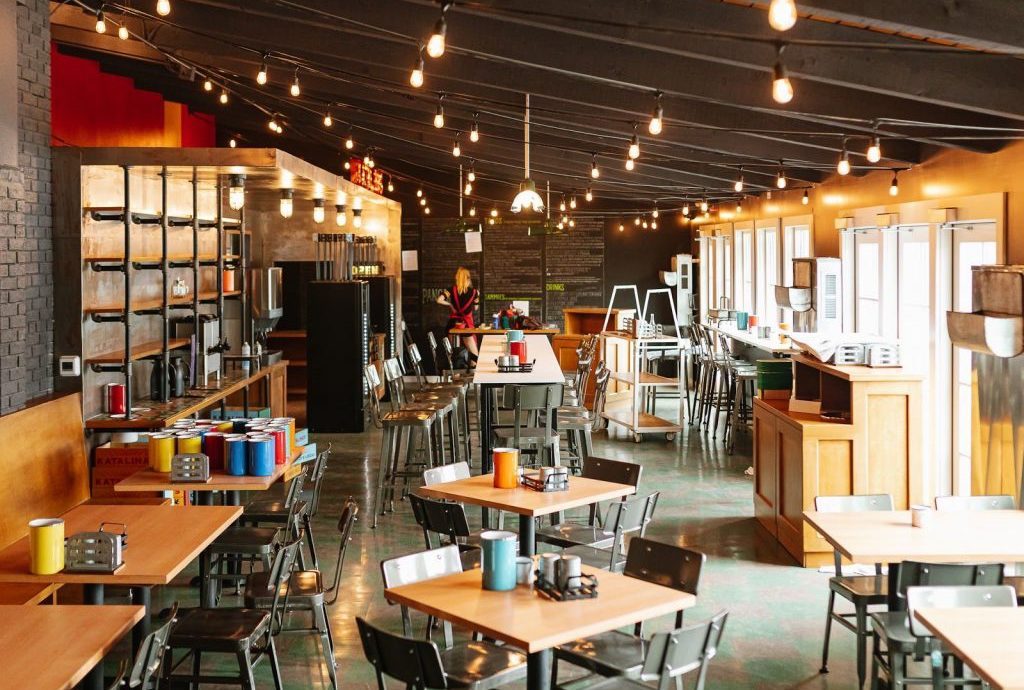Originally published in the August 2020 issue of (614) Magazine

Restaurant margins have always been thin, and the costs are often hidden. Manufacturing has materials, restaurants have ingredients. Retail may have slow days, restaurants have expiration dates. Factories don’t slow down at the clap of thunder, and shopping malls sometimes see a boost. But if your business is built around a bustling patio, between staffing and spoilage, you might actually lose money when the weather turns. It rains on everyone eventually, some more than others. And when it comes to a pandemic, it’s been raining on restaurants for months and the skies seem to be getting darker by the day.
Katalina’s epitomizes everything folks love about the Columbus culinary scene. The original location turned an abandoned gas station into a heralded Harrison West haunt, and the eponymous café in Clintonville transformed a vintage fountain pen store into something worth writing home about. Quirky and clever, it’s a kitschy kitchen that elevates each dish into art you can eat, and Instagram posts from her patrons are practically as pervasive as her signature pancake balls.
“I think restaurants are one of the safest places to be right now because they are monitored more than almost any business,” noted owner Kathleen Day, whose seasonal seating offered essential expansion for both locations. “I take all of my feedback from people like the Ohio Restaurant Association, the CDC, and the Columbus Health Department. And what we know now is that outdoor seating is safer than indoor seating.”
Not unlike curbside pickup or the serendipity of a drive-thru window, patios have become even more coveted in recent months for those who have them, and a bureaucratic hurdle for those hoping to add or expand one. For now, Katalina’s is focusing on takeout and delivery, which wasn’t even an option until it likewise became essential. But delivery services come at a high cost beyond just the percent of sales and added packaging expense for food that typically leaves the kitchen on a plate instead of in a bag. Concerns about quality control and the brand implications are sincere for restaurateurs already struggling to retain staff and remain open.
“A national chain doesn’t have the same kind of social media following at the local level, so they’re probably not under as much scrutiny as I am, especially with the new cancel culture. I will be under a microscope immediately,” she explained. “The restaurant industry has one of the lowest profit margins already, and I have extraordinarily high food costs on purpose because I use local, organic, and ethical food. If people want to go back to an era where we only have chain restaurants and large conglomerates, they may see that soon.”
Though the capital city is home to a number of notable national names, there is still a fierce loyalty to local businesses and brands. However, the fear of blowback is just as real as the added operating expense and emotional toll of potentially watching a lifetime of work slowly slip away over a matter of months. There are beloved local restaurants that simply will not survive, and for those that do, that price is also largely hidden.
“These are new costs for a lot of restaurants—take-out containers, paper menus, delivery services. They had to invest in new signage and if you’ve been inside restaurants lately, you’ve seen the decals on the floor and new signs. Stand Here. Don’t Go There,” explained John Barker, president and CEO of the Ohio Restaurant Association. “Availability of gloves and face coverings add even more pressure. Hand sanitizer is up to around $39 a gallon, which is triple what it would have been a year ago.”
The Ohio Restaurant Association has emerged as a lifeline, offering advocacy informed by a century of insight among its membership. (Really, the organization was founded in 1920.) The present pandemic has upended the industry more fundamentally than any crisis or cultural shift since prohibition.
Among their most visible initiatives are the Ohio Restaurant Promise, a pledge posted for patrons outlining steps taken to ensure their safety, and their Employee Relief Fund, offering financial assistance to those struggling during unprecedented times. From navigating complex government programs to securing necessary cleaning supplies, among the most pressing concerns facing restaurants are the specialized sanitizing procedures required after a positive case of COVID-19 is confirmed among guests or staff. The cost of cleaning, depending on the size of the restaurant, is typically several thousand dollars, and exceeds the standard expected of most businesses.
“We’re not seeing grocery stores closing down, or hardware stores closing down. In many cases a deep cleaning by the restaurant is all that’s required,” he noted. “But we have seen restaurants close, out of an abundance of caution, and we help them understand their responsibilities and to follow health department guidelines. Safety is always our first concern.”
Trust comes from transparency, and businesses like Stauf’s, Barcelona, and Katalina’s have set a new standard for being entirely open with employees and their clientele about interruptions, added procedures, and the extra steps they’re taking to continue serving customers safely, despite the current crisis.
“Katalina’s is Katalina’s because I have more long-term employees than the average restaurant, and I have the most amazing customers in the world. So right now, I’m going to do takeout and delivery,” Day noted, but confessed the future remains uncertain for her restaurant and the entire industry. “My customers are so loyal, they will sit out on my patio in the snow, and it amazes me and inspires my employees every time. But whether you have a patio or not, for small restaurants struggling to survive, it’s going to be a really rough winter.” ▩
For the latest on Katalina’s, follow them social media and at katalinas.com
For more on the Ohio Restaurant Association, the Ohio Restaurant Promise, and their Employee Relief Fund, visit ohiorestaurant.org